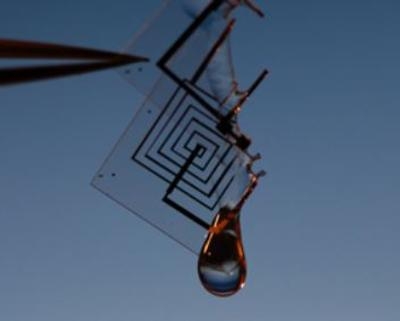Program Aims To Develop Systems That Deliver The Goods, Then Poof Out Of Existence
It sounds like an engineering fantasy, or maybe an episode from Mission Impossible: A flock of small, single-use, unpowered delivery vehicles dropped from an aircraft, each of which literally vanishes after landing and delivering food or medical supplies to an isolated village during an epidemic or disaster. And it would be nothing more than a fantasy, were it not that the principle behind disappearing materials has already been proven.

Building on recent innovations in its two-year-old Vanishing Programmable Resources (VAPR) program, which has developed self-destructing electronic components, DARPA today launched ICARUS, a program driven by a vision of vanishing air vehicles that can make precise deliveries of critical supplies and then vaporize into thin air.
“Our partners in the VAPR program are developing a lot of structurally sound transient materials whose mechanical properties have exceeded our expectations,” said VAPR and ICARUS program manager Troy Olsson. Among the most eye-widening of these ephemeral materials so far have been small polymer panels that sublimate directly from a solid phase to a gas phase, and electronics-bearing glass strips with high-stress inner anatomies that can be readily triggered to shatter into ultra-fine particles after use. A goal of the VAPR program is electronics made of materials that can be made to vanish if they get left behind after battle, to prevent their retrieval by adversaries.
“With the progress made in VAPR, it became plausible to imagine building larger, more robust structures using these materials for an even wider array of applications. And that led to the question, ‘What sorts of things would be even more useful if they disappeared right after we used them?’” Olsson said. “In discussions with colleagues, we were able to identify a capability gap that we decided was worth trying to close.”
From those deliberations emerged ICARUS, the mythology-alluding acronym for Inbound, Controlled, Air-Releasable, Unrecoverable Systems. Described today in a Broad Agency Announcement (DARPA-BAA-16-03, published on October 9, 2015, is available on FedBizOpps. The two-phase program is slated to last 26 months with total funding of about $8 million.
The millennia-old Icarus story ends badly when the protagonist, soaring with youthful abandon on wings of feather and wax, flies too close to the sun and then falls and drowns in the ocean as his wings disintegrate. DARPA’s new ICARUS program aims to mimic the material transience that led to Icarus’ demise, but leverages that capacity in scenarios with more uplifting endings.
In one program-driving scenario, troops are called upon to deliver food, perishable vaccines, insulin, and blood and plasma products to widespread, difficult-to-reach destinations in the aftermath of an earthquake or tsunami. The option to forget entirely about the remains of all those delivery vehicles once they have done their job would relieve response teams from the logistics task of packing and transporting the vehicles out of the affected region while essentially eliminating environmental impacts from the vehicles’ deployment.
In a military context, access to small, unmanned delivery systems whose structural and avionics components were made with transient materials could ease the provision of, say, water, batteries or emergency medical supplies without adding to a unit’s pack-out-burden.
“Vanishing delivery vehicles could extend military and civilian operational capabilities in extenuating circumstances where currently there is no means to provide additional support,” said Olsson, adding that he is optimistic the program will attract talented and created partners because it involves such interesting science and engineering. “Inventing transient materials, devising ways of scaling up their production, and combining those challenges with the hard control and aerodynamic requirements to reach the precision and soft-landing specs we need here makes for a challenging and compelling engineering problem.”
(Image provided by DARPA: Progress in the development of vanishing polymers has opened pathways toward vanishing systems, such as air-dropped delivery vehicles.)
 ANN's Daily Aero-Term (04.26.24): DETRESFA (Distress Phrase)
ANN's Daily Aero-Term (04.26.24): DETRESFA (Distress Phrase) Aero-News: Quote of the Day (04.26.24)
Aero-News: Quote of the Day (04.26.24) ANN's Daily Aero-Term (04.27.24): Direct
ANN's Daily Aero-Term (04.27.24): Direct ANN's Daily Aero-Linx (04.27.24)
ANN's Daily Aero-Linx (04.27.24) Aero-News: Quote of the Day (04.27.24)
Aero-News: Quote of the Day (04.27.24)



